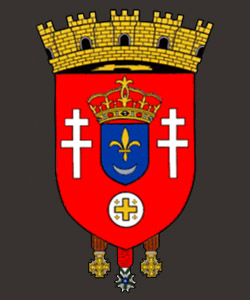Calais's emblems
Summary
The arms of the city of Calais
The flag of the city of Calais
Calais, contrairement à d'autres villes, a conservé ses emblèmes historiques : ses armoiries et son drapeau...
The arms of the city of Calais
Origin and evolution of heraldic figures
If in ancient times individual city emblems or symbols decorated the shields infantry, they only became fixed and inherited, through the arms, that from the nineteenth century. Originally, they can recognize the armed fighting. Their use was subsequently expanded in the nobility, then throughout society to designate both commoners, clerics, corporations such as municipalities or corporations.
Under the Old Regime, the arms were subject to a special authorization. Calais occupied for 211 years will be granted its own coat of arms to the recovery of the city by Henry II in 1558. The arms had been abolished during the Revolution (1791 and 1792 decrees), these should be the subject of a new application under the Restoration. The royal decree of 26 September 1814 "allowed the cities, municipalities and corporations to take the arms that had once been granted to them". Many cities took their arms without authorization, this was not the case of Calais who was officially confirmed his arms April 19, 1817 by Louis XVIII.
Royal Order of April 19, 1817
« Wanting to give our loyal subjects of cities and towns of our kingdom a token of our affection and to perpetuate the memory we keep the services that their ancestors made to kings our predecessors services enshrined in the arms that were previously granted to those cities and common, and they are the emblem, we have our order of 26 September 1814, authorized the cities, municipalities and corporations of our kingdom to resume their ancient arms […] »

Heraldic description
Écu de GUEULES in Crest abyss Azure a GOLD FLEUR DE LYS and a SILVER CRESCENT crest and a CROWN ROYAL closed gold ; escutcheon supported a besant charged with a CROSS OF JERUSALEM leaning and two silver patriarchal cross or CROSS OF LORRAINE. The shield is topped with a golden CROWN WALL masonry sand with five laps to sandy bays.
Representation
The GUEULES… red, symbol of passion and courage, reminiscent of the tumultuous life of the city and the courage with which its citizens have defended the city...
The CROSS of LORRAINE… here do not symbolize France free which allied behind General De Gaulle during World War II, in contrast with the swastika of the Nazis, since the arms are much earlier in the twentieth century. They actually represent the family of the Dukes of Lorraine which was from the Duke of Guise Francis de Lorraine, who restored Calais in France January 6, 1558 after 211 years of British occupation.
The FLEUR DE LYS D'OR and ROYAL CROWN : these royal symbols evoke ultimate satisfaction of royal power to recover Calaisafter the English occupation and that of the population in Calais.
CROSS OF JERUSALEM and SILVER CRESCENT : they evoke the passage of French and English crusaders in the city whose existence was officially recognized from the twelfth century.
CROWN ROYAL (...) with five TOURS : it reminds us that the city was fortified as early as the thirteenth century. The fortifications, originally made of wood, were later replaced by stone enclosures which were added towers.
Three DECORATIONS MILITARY : the city received the Legion of Honor, center, and the Croix de Guerre 1914-1918 and 1939-1945. They are contained in outdoor ornaments.
The flag of the city of Calais
Origin
Reminder: the flag means a piece of cloth attached to a shaft and carries the colors or emblems of a given group to serve as a rallying sign, symbol…
Originally, it was simple banners, namely the "flags" that are suspended vertically or by a horizontal cross. The flag as we know it today appeared in China around 300 BC before spreading up to Asia Minor.
In Europe, it is mostly developed during the Middle Ages to more easily identify people and lines. Indeed, the arms were often represented.
King Charles VII (1403-1461) did much to develop the use of French flags, including shipping, in order to reassert royal authority: it was under his reign that France was undermined both because of the civil war between the Burgundians Armagnacs, but also because of the so-called war of 100 years with England (1337-1453). He managed to end these two wars, the Treaty of Arras with the Burgundians in 1435 where he first grants a number of territories, and finally by the peace treaty with the British in 1453.
He promulgated and royal decrees aimed particularly at sea ports on reclaimed land as Boulogne-sur-Mer, Le Havre and St Malo... These orders set the rules and dimensions to follow: the pavilions were to be no bangs, rectangular and reaffirm the membership of these cities to the French crown…
Calais, which was occupied until 1558 by the English, only adopted its flag at the end of the sixteenth century…
Later, he floated the masts of merchant ships of Calais and the masts of privateers including that of Tom Souville.

Description
The Calais pavilion has two parts to the luff (height) for the three leaf (length). The width of the band cross is 1 / 5th of the height, the vertical arm of the cross is in the first third of the length of the side of the stem, as in the Scandinavian flags. There is no bangs. The staff (when present) ended with a pike iron.
The background color of the flag is azure blue and is crossed with a white cross.
Note: the cross was originally red but the French had to change color because of ... English…
Representation
The WHITE CROSS has no religious significance. It is a sign of recognition of the king's infantry regiments and navy that some ports such as Calais, St Malo and Le Havre have adopted.
The color BLUE AZUR with or without lilies symbolize the rallying of the French nation against the English belligerents.
Glossary…
CARNATION: ring for passage of the halyard.
The FLEURON: ornament worn on the top of the pole; generally made of metal and shaped lance.
The HAMPE: wooden handle on which the flag is stapled or nailed.
The HALYARD : rope for hoisting the flag.
The KNOB: circular plastic sleeve attached to the masthead under the flagship; it contains a pulley through which passes the halyard.
The MAST: metal part or fiberglass on which is hoisted a flag; it may be vertical or oblique (a front).
The MAST ANTI-WORKING: With this patented system, the pavilion will be wrapped around most of its support.
The STEM: metal bar at the top of a mast to maintain the upper edge of a flag.
